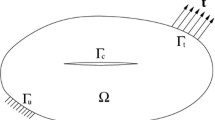Abstract
At first, a hybrid boundary element method used for three-dimensional linear elastic fracture analysis is established by introducing the relative displacement fundamental function into the first and the second kind of boundary integral equations. Then the numerical approaches are presented in detail. Finally, several numerical examples are given out to check the proposed method. The numerical results show that the hybrid boundary element method has a very high accuracy for analysis of a three-dimensional stress intensity factor.
Similar content being viewed by others
References
Annigeri, B.S. and Cleary, M.P., (1984). Surface integral finite element hybrid (SIFEH) method for fracture Mechanics. International Journal of Numerical Methods in Engineering 20, 869–885.
Atluri, S.N. and Kathiresan, K., (1979). 3D analysis of surface flaws in thick-walled reactor pressure–vessels using displacement-hybrid finite element method. Nuclear Engineering and Design 51, 163–176.
Atluri, S.N., Kathiresan, K. and Kobayashi, A.S., (1975). Three-dimensional linear elastic fracture mechanics analysis by a displacement-hybrid finite element medel, Trans. 3rd Int. Conf. on Struct. Mech. in Reactor Technology, Paper No. L-7/3, London.
Barsoum, R.S., (1976). On the use of isoparametric finite element in linear fracture mechanics. International Journal of Numerical Methods in Engineering 10, 25–37.
Belytschko, T., Chang, H.S. and Liu, Y.Y., (1989). A variationally coupled finite element-boundary element method. Computer and Structures 33, 17–20.
Blandford, G.E., Ingraffea, A.R. and Liggett, J.A., (1981). Two-dimensional stress intensity factor calculations using boundary element methods. International Journal of Numerical Methods in Engineering 17, 387–404.
Bui, H.D., (1977). An integral equation method for solving the problem of a plane crack of arbitrary shape. Journal of the Mechanics and Physics of Solids 25, 29–39.
Cruse, T.A., (1975). Boundary Integral Equation Method for Three-Dimensional Elastic Fracture Mechanics Analysis, AFOSR-TR-75-0813.
Cruse, T.A. and Vanburen, W., (1971). Three-dimensional elastic stress analysis of a fracture specimen with an edge crack. International Journal of Fracture Mechanics 7, 1–16.
Farris, T.N. and Liu, M., (1993). Boundary element crack closure calculation of three-dimensional stress intensity factors. International Journal of Fracture 60, 33–47.
Gray, L.J., Martha, L.F. and Ingraffea, A.R., (1990). Hypersingular integrals in boundary element fracture analysis. International Journal of Numerical Methods in Engineering 29, 1135–1158.
Guozhong Chai, Kangda Zhang and Dongdi Wu, (1994). The unified second kind boundary integral equation in fracture mechanics. Journal of Zhejiang University of Technology 1, 13–21 (in Chinese).
Ioakimidis, N.I., (1982a). A natural approach to the introduction of finite-part integrals into crack problems of three-dimensional elasticity. Engineering Fracture Mechanics 16, 669–673.
Ioakimidis, N.I., (1982b). Application of finite-part integrals to the singular integral equations of crack problems in plane and three-dimensional elasticity. Acta Mechanica 45, 31–47.
Isida, M., Yoshida, T. and Noguchi, H.,(1990) Tension of a finite-thickness plate with a pair of semi-elliptical surface cracks. Engineering Fracture Mechanics 35, 961–965.
Isida, M., Hirota, K., Noguchi, H. and Yoshida, T., (1985). Two parallel elliptical cracks in an infinite solid subjected to tension. International Journal of Fracture 27, 31–48.
Jia, Z.H., Shippy, D.J. and Rizzo, F.J., (1988). Three-dimensional crack analysis using singular boundary elements. International Journal of Numerical Methods in Engineering 28, 2257–2273.
Li H.B., Han G.M., Mang H.A. and Torzicky P., (1986). A new method for the coupling of the finite element and boundary element discretized subdomains of elastic bodies. Computer Methods in Applied Mechanics and Engineering 54, 161–175.
Liu, Y.Y., Belytschko, T. and Liu, W.K., (1991). A variationally coupled FE-BE method for elasticity and fracture mechanics. Computer Methods in Applied Mechanics and Engineering 85, 21–37.
Luchi, M.L. and Rizzuti, S., (1987). Boundary elements for three-dimensional elastic crack analysis. Intnational Journal of Numerical Methods in Engineering 24, 2253–2271.
Marcal, P.V., (1972). Three-dimensional finite element analysis for fracture mechanics. In: The Surface Crack: Physical Problem and Computational Solutions (edited by Swedlow, J.L.), ASME.
Murakami Y., (1985). Analysis of stress intensity factors of Mode I, II and III for inclined surface cracks of arbitrary shape. Engineering Fracture Mechanics 22, 101–144.
Nisitani, H. and Murakami, Y.,(1974). Stress intensity factors of an elliptical crack or a semi-elliptical crack subject to tension. International Journal of Fracture 10 (3), 353–368.
Raju, I.S. and Newman, J.C. Jr., (1979). Stress-intensity factors for a wide range of semi-elliptical surface cracks in finite–thickness plate. Engineering Fracture Mechanics 11, 817–829.
Shah, R.C. and Kobayashi, A.S., (1971). Stress intensity factor for an elliptical crack under arbitrary normal loading. Engineering Fracture Mechanics 3, 71–96.
Tan, C.L. and Fenner, R.T., (1979). Elastic fracture mechanics analysis by the boundary integral equation method. Philosophical Transactions of the Royal Society of London A369, 243–260.
Tracy, D.M., (1973). 3D elastic singularity element for evaluation of K along an arbitrary crack front. International Journal of Fracture 9, 340–343.
Zienkiewicz, O.C., Kelly, D.W. and Bettess, P., (1977). The coupling of the finite element method and boundary solution procedures. International Journal of Numerical Methods in Engineering 11, 355–375.
Author information
Authors and Affiliations
Rights and permissions
About this article
Cite this article
Guozhong, C., Kangda, Z. A hybrid boundary element method for three-dimensional fracture analysis. International Journal of Fracture 104, 239–256 (2000). https://doi.org/10.1023/A:1007697717150
Issue Date:
DOI: https://doi.org/10.1023/A:1007697717150




